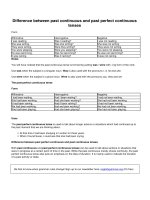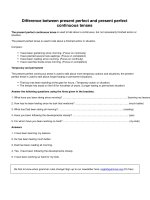Present perfect continuous tense
Bạn đang xem bản rút gọn của tài liệu. Xem và tải ngay bản đầy đủ của tài liệu tại đây (12.01 KB, 1 trang )
Present perfect continuous tense
Form: has / have + been + ing form of the verb
Affirmative Question Negative
I have been working. Have I been working? I have not been working.
He has been working. Has he been working? He has not been working.
She has been working. Has she been working? She has not been working.
They have been working. Have they been working? They have not been working.
We have been working. Have we been working? We have not been working.
You have been working. Have you been working? You have not been working.
Uses
The
present perfect continuous tense
is used to talk about situations which started in the past and are still
going on.
I have been gardening since morning.
It has been raining since yesterday.
Rani has been studying since morning.
Father has been working for six hours.
Rahul has been playing for hours.
They have been waiting for long.
Difference between present perfect and present perfect continuous tense
Both present perfect and present perfect continuous tenses can be used to talk about situations that started in the
past and are still going on. The present perfect continuous tense is preferred in cases where we want to say how
long a situation has lasted.
To simply show the continuity of an action, we use the present continuous tense. The present perfect tense is
used in cases where the focus is on the idea of completion.
I
have written
six letters since morning. (Focus on the idea of completion)
He
has eaten
a whole loaf of bread.
I
am writing
a letter. (Focus on the idea of continuity with no reference to duration)
I
have been writing
since morning. (Focus on the continuity and duration of the idea)
Be first to know when grammar rules change! Sign up to our newsletter here: englishgrammar.org (It's free)
Powered by TCPDF (www.tcpdf.org)









